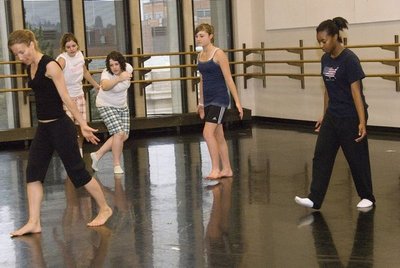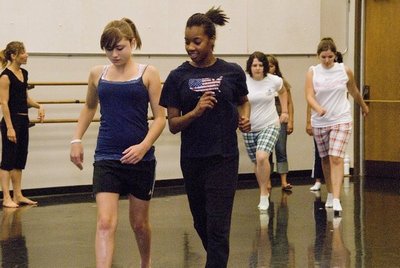August 21, 2008
All that dance: High schoolers eyes open to dance through GEAR UP program
For the last two winters, Jennifer Salk’s students have brought the joy of dance to a group of middle and high school students in Central Washington. Now some of those students — from Goldendale and East Valley High schools — are here on campus for more of the same. Thanks to funding from the GEAR UP program, the 20 visitors are getting instruction in dance from faculty and community professionals while getting a taste of life on the UW campus.
GEAR UP stands for Gaining Early Awareness and Readiness for Undergraduate Programs. It’s funded by the U.S. Department of Education and is designed to increase the number of low-income students who are prepared to succeed in post-secondary education. The students are part of a cohort that has been followed and given various supports since they were in the fifth grade.
Salk, an associate professor of dance, has taken her class in teaching methods to Eastern Washington for the past two years. There, the students get to teach kids, most of whom have no dance experience. They take over physical education classes in several area schools and teach an after-school workshop for the GEAR UP students. Each UW student who goes stays for one day and teaches three PE classes plus the after-school workshop. Salk is there for the week, to oversee the action.
For most, the experience is a trial by fire. Before going, the UW students have spent five weeks in class getting their lesson plans together and preparing their materials. They’ve also had some teaching experiences — but only in programs where the students choose to be there. Teaching a required class in a public school is another matter.
Salk says she tells them at the beginning of class, “I know this is going to disrupt your life and as you get closer to this you’ll end up being anxious, you’re not going to want to go. But I guarantee you, at the end of that day, you’re going to feel either, ‘I never want to teach again,’ or ‘totally inspired and invigorated.'”
Either way, she says, students are deeply affected by what happens. “They say, ‘That was the best thing I’ve ever done,’ or ‘I’m so glad I did that.’ They feel really good about the experience.”
That’s despite the fact that some of the schools the students visit are difficult ones where they have challenges managing the classroom while trying to give the kids a good movement experience.
Alice Gosti, a recent UW graduate who taught dance in Central Washington, told about how she and another UW student with whom she team-taught met classes where students refused to move.
“We were teaching movement and they were not moving. So my partner and I just said, ‘We’ll keep going.’ And by the end they were dancing. They were playing with us, they were doing the exercises. It was a difficult situation, knowing these kids didn’t want to be there initially, but knowing that what you’re doing could help them.”
The after-school workshop, which takes place every day for a week, is a different matter, however. There are only about 15 kids in that group, and they have a lot of fun learning everything from ballet to modern dance, salsa and hip hop.
“They were more interested in what we were doing and willing to take more risks,” says SarahRose Bernhardt, another recent graduate who taught in the program. “They were really thirsty for anything we could give them.”
Salk says that at the end of the week the UW students ask the kids what they’ve learned, and one of the most common responses is, “I had no idea there were so many different kinds of dance.”
“We’re used to being on a university campus where the arts are known and respected,” Gosti says, “but for a lot of these kids, the only dance they’ve ever seen is what’s on TV.”
Opening students’ eyes to new forms of dance is gratifying, but what’s even more gratifying are the responses such as this one from a female student: “You gave me confidence that I didn’t have a week ago — confidence in my body and how I feel about my body.”
Salk says another byproduct has been a breakdown of barriers between cliques or groups of kids in the program. “They knew each other but I don’t think they hung out together,” she says. “By the end they were dancing together and partnering each other and they talked about that too. They said it was nice to get to know people they didn’t know before.”
At the summer dance camp — which has been going on this week — the Central Washington students are spending all day dancing. In the morning they are split into two groups and are being taught a brief dance that they’ll perform, while in the afternoon the whole group has worked together creating its own choreography under the direction of Assistant Professor Jurg Koch.
In the late afternoon there have been master classes in dances such as salsa and capoeira. The evening is given over to activities such as a campus tour, a swim in Lake Washington and a visit to the Pacific Science Center. At 3:10 p.m. Friday, Aug. 22, the students will perform the dances they’ve learned in Studio 267 in Meany Hall.
Bernhardt, Gosti and two other UW students who taught in Central Washington are serving as class chaperones for the kids, meaning they attend class with them and help out as needed.
Salk is thrilled with the camp, which is being offered this year for the first time. “The kids who come here are really getting to see what it’s like to be on campus for a week,” she said. “If it goes well this year, we’re talking about expanding it next year.”


